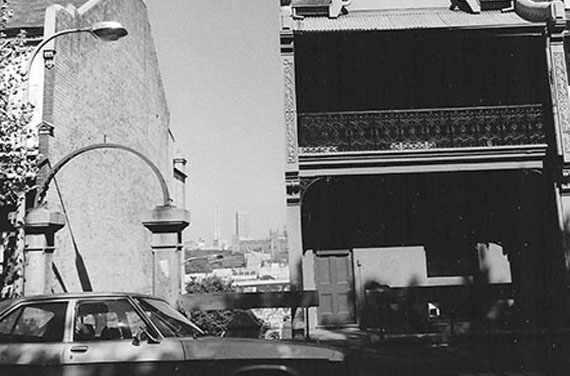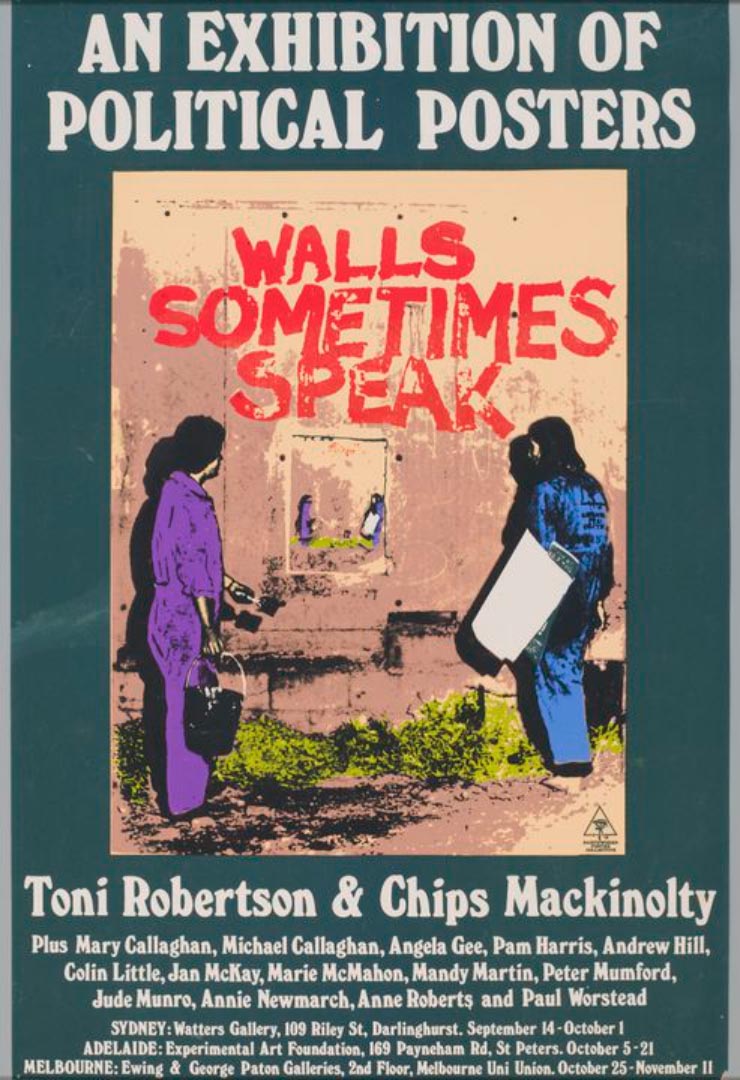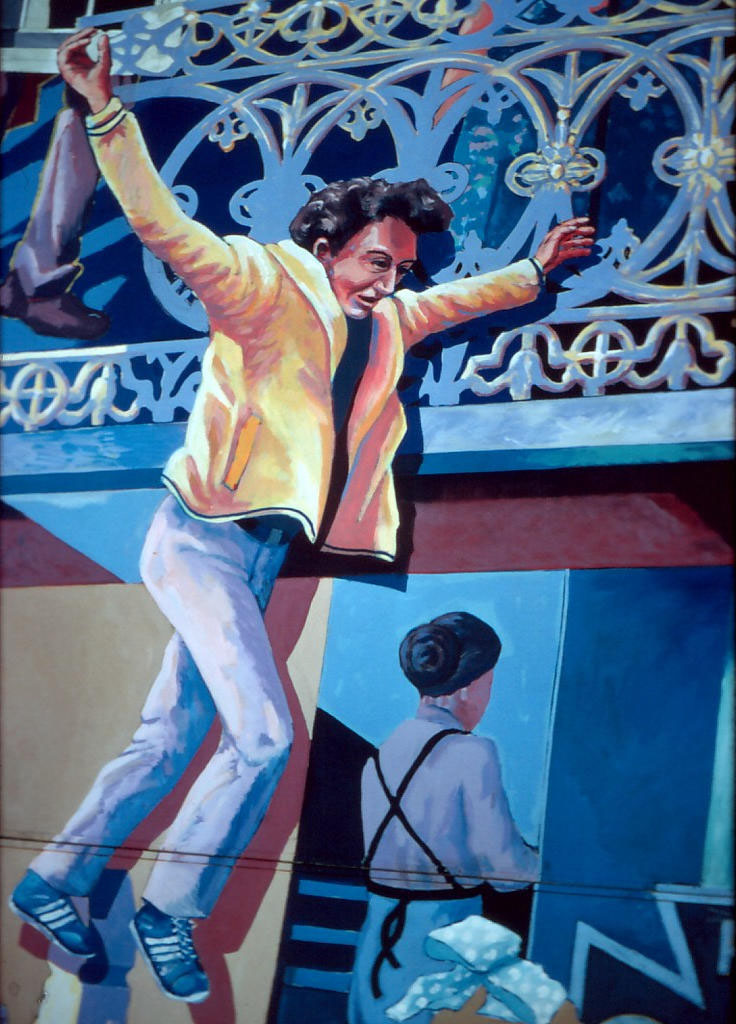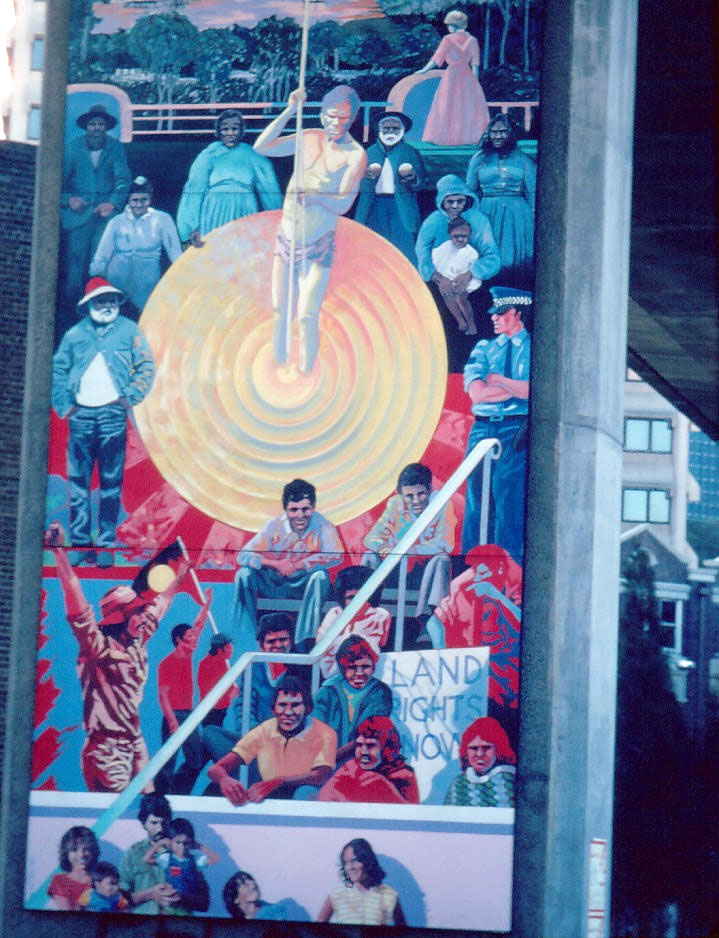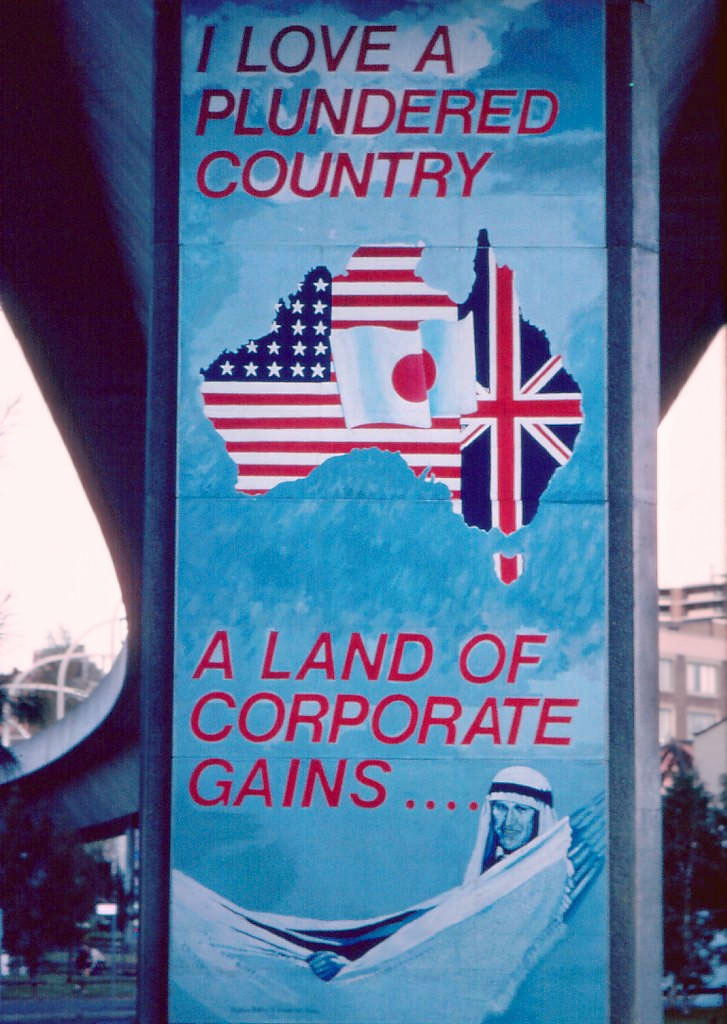Green Bans Art
Art & Green Bans (1971-1984)
Protest posters produced by Australian artists and designers during the 1970s and 1980s are some of the greatest examples of poster art produced anywhere in the world. (Peter Vincent, Up against the Wall, Sydney Morning Herald, Money p15, 15 October 2003). After 15-years of Federal conservative governments, this period was a time of major social and political change following the Vietnam War and the rise of the anti-nuclear, international peace, anti-apartheid, environmental and women's movements. The period culminated with the the shocking dismissal of the Whitlam Labour Government by the Governor-General on 11 November 1975.
Initially Green Bans posters were hand made for example, Green Ban Tree’ (1973, attrib. Margaret Grafton), Brenda Humble, a member of ROW, made posters and later an artist’s book, Save the 'Loo Now (1977.) Later, big bright Earthworks Posters from the Tin Sheds appear, notably by Chips Mackinolty (Mick Fowler’s Jazz send-off, 1979 with crochet by Francis Budden); for Pat Fiske’s film of the BLF, ‘Rocking the Foundations’, 1985) and Jan Mackay (‘Remember Juanita’, 1975.) Margel Hinder’s sculpture, ‘Aphrodite’, a bronze memorial fountain in Denis Winston Place (1981) celebrates their achievement.
Apologies to those omitted. Please contact us!
Artists
Anon: Art & Woolloomooloo Unofficial Murals (Graffiti)
Murals are a feature in the Loo. Matron Olive O’Neill, age 86 probably put up the first banner: Hands off! THIS COULD BE YOUR HOUSE! Nell Leonard said: We got these big pieces of board and wrote on it “homes for people not office blocks for foreign investors” and put them on the houses at night. (Fitzgerald, pers. com., in Sydney 1842-1992.) Brenda Humble and her two children painted “We love the loo” while her friend Susan Tooth painted “Robert Askin loves Laura Norda”. The Rainbow Serpent appeared at 19 Harmer St (1973-4). The vernacular tradition continues with Wall Art at Sydney Place, at Dowling St Container Garden and Bourke Street Park.Anon: Mock Funeral for the death of low-cost housing in Victoria St, 1975
A plaque to Mick Fowler’s memory is on the pillar at the top of McElhone Stairs and reads: “Memorial Plaque/to/Mick Fowler/Seaman, Musician & Green Bans Activist/ 1927-1979/For his gallant stand against demolition / of workers homes with the Builders /Labourers Federation Green Bans/ They were hard old days, they were battling days they were cruel but then in spite of it all, Victoria Street will see low income housing for workers again from his friends.”
Margel Hinder
Bronze Sculpture and Fountain, Denis Winston Place, Wooloomooloo. The Denis Winston Memorial Committee of the Planning Research Centre, University of Sydney raised funds for a memorial sculpture to commemorate the legacy of Denis Winston and the Woolloomooloo Estate. They commissioned eminent sculptor Margel Hinder to create a memorial to the achievement of the town planning movement to stand in Denis Winston Place, a square designed by Mike Ewings. Sir Hermann David Black, the university Chancellor, officiated at the turning on of the fountain and the grand opening of Denis Winston Place for the Housing Commission of NSW in October 1981. Hinder’s playful work celebrates human scale, diversity in housing, landscaped spaces and sculpture as essential to the pleasures of urban living. It initially complemented a small children’s playground (removed) and incorporated a fountain and splash pool (de-commissioned). Margel Hinder’s public sculpture has been compared by her biographer Rene Free to Barbara Hepworth, as both artists use form in an absolute sense. Hinder, uses symmetry as central to her art. Her large public sculptures include her masterpiece, the Captain Cook Memorial Fountain in Civic Park, Newcastle (1961-66). New York born Hinder came to Australia in 1934 after she married Australian artist Frank Hinder with their daughter, Enid.Links: Margel Ina Hinder, DAAO - https://www.daao.org.au/bio/margel-ina-hinder/ and ‘Winston Square Opens’, University of Sydney News, 21 October 1981.
Peter Kennedy
“Juanita”, dagger and dollar stencil, shop in Kings Cross. Late 1974. Reproduced by Mini Graff for 2011 Green Bans Art Walk. Negative from Tribune photographic archive, State Library of NSW.Jan Mackay
Property & development carry the obligation to exploit. In memory of Victoria St Kings Cross, 1977.Place: Victoria Street, Kings Cross, Sydney, New South Wales, Australia.
Poster, screenprint, printed in colour inks, from multiple stencils.
Dimensions, sheet 63.4 h x 50.8 w cm Edition: print run unknown
The artist notes: Not Earthworks, produced at my flat in Victoria Street, Kings Cross [Jan Mackay to Roger Butler, 2006]
Collection National Gallery Australia.
Chips Mackinolty
Chips Mackinolty (born 1954 in Morwell, Victoria, Australia) artist and writer. Chips was involved in the campaigns against the war in Vietnam by producing posters. He was a key figure in the radical poster movement and was introduced to screen printing in Goulburn Street, Sydney. For more than four decades he has lived in Darwin where he has worked for Australian Aboriginal and non-Aboriginal organisations as an advocate, a researcher, journalist, graphic artist and designer. His prints and political posters have been included in more than 200 group and solo exhibitions in Australia and abroad in the past forty-five years, and his work is represented in public and private collections nationally and internationally. He was a member of the Earthworks Poster Collective (1973–1980). Members of the collective initiated a notable touring exhibition called The Walls Sometimes Speak of posters from this period. In the 1990s he establish Green Ant Research Arts & Publishing with Peter Cooke and Therese Ritchie in Darwin. a retrospective exhibition by Therese Ritchie & Chips Mackinolty, Not dead yet, At Charles Darwin University by Art Gallery Curator Anita Angel, was held in 2010.Image: Chips Mackinolty, Jack Mundey, 2020. Commemorative digital poster.
Marion Marrison (Hardman)
Marrison was a young photographer who, with writer Peter Manning, published Green Bans, a photobook which covered the fight to save Victoria Street and Woolloomooloo, published by the Australian Conservation Foundation in 1975.Marion Marrison Artist Statement, October 2020: In late 1973 I was the first photography graduate from the Tasmanian School of Art in Hobart just as the Publications Committee of the Australian Conservation Foundation decided to publish a book documenting Sydney's Green Bans. I had just started exploring and photographing local bushland and was initially reluctant to put that aside for the months it would take to see the Green Bans project completed. Tasmanian environmental campaigners Dr. Richard Jones and Geoff Parr were members of that committee and offered a return plane ticket and the contact of Leigh Holloway at the Sydney branch of the Wilderness Society. It was my second trip to Sydney and the first on my own. Looking at the maps provided, the Green Bans covered an extensive area including green spaces in outer suburbs but it seemed to me that the crux of the bans was a crucial, historical belt of inner Sydney comprising The Rocks, Glebe, Ultimo, Waterloo, Centennial Park, Victoria St and Wolloomooloo. On the northern side of the harbour, was the one that started it all, Kelly’s Bush. The book was conceived around the visual and Peter Manning’s text followed from the photographs. The photographs were undertaken in two trips, the first before Christmas 1973 and the follow up in late January 1974. On both occasions, I had only one opportunity to visit an area or person and had to work with whatever conditions were presented. I had never photographed buildings or streetscapes and often had to make the best of overcast conditions or building facades in heavy shade. Editing after the first trip, I realised the project lacked people and most of the second visit was for the portraits. Jack Mundey agreed to be photographed over lunch at Diethnes, I took one roll of twelve exposures. He looked directly at the camera only twice and moved in two of the others. Unsurprisingly, he was talking and never really still. I prefer this photograph to the one in the book, it seems ‘more’ Jack. The book was launched in 1975 by Dr. Jim Cairns in an exhibition of the photographs at the Arts Council of NSW Gallery in Darlinghurst. The experience of making this work and meeting the remarkable and courageous people of the Greens Bans remains a unique and cherished opportunity.
Joe Szabo
Painter and musician living on Victoria St who organised a fundraising exhibition at The Stables, 109 Victoria Street with works from artists associated with the area including Charles Blackman, Sali Herman, Brett Whitley, Peter Upward, Stan Rapotec. At the opening, Mick Fowler's jazz band, the Fowlhouse Five played Dixieland upstairs.Posters & Green Bans (1971-1984)
Poster featuring portrait image Mick Fowler's head and shoulders with a smaller image of a man on the ground being dragged by two men and an image of a crocheted doily featuring the text, 'Who killed Juanita Developers Now save Victor'. Artists Marie McMahon and Frances (Budden) Phoenix co-founded he Women's Domestic Needlework Group (WDNG) and researched and documented the D'oyley Archive and in 1979 mounted 'The d'oyley show: an exhibition of women's domestic fancywork' at Watters Gallery.Wording includes: 'Thursday November 1st, 8.00 P.M. / Films 'Street Music' 50 min about Victoria / Street Kings Cross, May Day, 1976 / Rushes of Mick leaving his room, May 1976 / Video: 'Who killed Juanita Nielson?' / Jazzmen bring instruments! / His soul goes marching on!! / Filmmakers Cinema / St Peters Lane, Darlinghurst, PH: 330 721'.
Chips Mackinolty, 'Remember Mick Fowler'... Filmmakers Cinema, 1979. Screenprint, printed in colour, from two stencils, printed by Earthworks Poster Collective, Sydney. Chips Mackinolty with doily by Frances Phoenix.
Image courtesy: http://www.printsandprintmaking.gov.au/works/13956/images/3767/
Earthworks Poster Collective silkscreen posters referencing Green Bans, 1976-1980:
Barbara Hall and Jan Mackay, Victoria St., April 1973 to now: bribery, thuggery, one week evictions, intimidation [etc.], 1976. Held, ML SLNSW.Chips Mackinolty, Woolloomooloo, a film by Denise White, Pat Fiske & Peter Gailey, plus The Settlement by Gill Leahy & Push On by Pat Fiske & Lee Chittick, 1977. Held, ML SLNSW.
Chips Mackinolty, Eviction Notice, Cockroach Realty, 1977. Held, ML SLNSW.
Toni Robertson + Chips Mackinolty, Walls sometimes speak. An exhibition of political posters. 1977. Held, ML SLNSW.
Our power lies in organisation. Support builders labourers for democratic control. No date. Held, ML SLNSW.
Margaret Grafton
Margaret Grafton was active in the Green Bans period: she co-founded Darlinghurst Resident Action Group with architect Colin James and city councillor Robert Tickner in 1973. The green bans tree was pasted “everywhere” in Darlinghurst and Woolloomooloo. Margaret Grafton wrote to Jack Mundey: “Our Green Ban Posters are at last printed and you could say our toes at least, are dug in. Thank you for your support. P.S. Think you’re marvellous!” (Darlinghurst Resident Action Group, Letter to BLF, 7 May 1973.)One of the few independent weavers in Australia, she worked on public commissions from Palmer Street in Darlinghurst. Her last large-scale narrative tapestry had faith and feminism as themes and celebrates the founding of St Vincent’s Hospital by the Sisters of Charity. See https://www.crossart.com.au/exhibition-archive/105-2006-exhibitions-projects/217-margaret-grafton-weaving-in-metal-26-august-to-16-september-2006
Image: Margaret Grafton (attrib), ‘BLF Green Ban Tree’, May 1973.) Two-colour poster. 73.5 x 89cm. Collection Sydney Trades Hall Association.
R.E. (Mac) Taplin
The Walls Sometimes Speak: An Exhibition of Political Posters, 1977.
Curated by Toni Robertson and Chips Mackinolty.Place Made: Tin Sheds Art Workshop, University of Sydney, City Road, Darlington, Sydney.
Posters Woolloomooloo
Film
Review of Waterloo by Gay Hawkins, SHELTER Magazine - https://www.tomzubrycki.com/articles/waterloo
History / Archive Projects
Woolloomooloo Official Murals: Green Bans History Murals and Women and Arts Festival Mural 'Women At the Edge of Town', 1982
The removed murals feature in the video by Midnight Oil for the song Power and Passion (1983.) Merilyn Fairskye and Michiel Dolk painted the History Panels and co-ordinated the project. Two groups of Billboard Panels (removed) are by Robert Eadie, Bob Clutterbuck, Angela Gee, Tim Maguire, Ruth Waller, Toby Zoates, Robin Hecks and Grahame Kime and Vicki Varvaressos. This was initiated, supported and funded by resident donations, assisted by the BLF, FEDFA, Council, NSW Premiers Department and the Australia Council. The Housing Commission donated a large warehouse as a studio and State Rail the pylons. The Women and The Arts Festival Mural (1980-83), on the Domain Carpark wall, St Mary's Road: co-ordinated by Carol Ruff, designed by Jan Mackay, Marie McMahon and Ruff. Mural painting team was Carol Ruff, Jan Mackay, Marie McMahon, Nora Bindul, Helen Skye, Barbary O'Brien and Merilyn Fairskye. A City Sculpture Walk by curator Sally Couacaud included works referencing Woolloomooloo by Robyn Backen, ‘Archaeology of Bathing’, Nigel Heleyer, sound sculpture below Boy Charlton Pool and Debra Phillips, ‘Women Women and The Arts Festival Mural (1980-83), Domain Carpark wall, St Mary's Road.
Woolloomooloo: Green Bans History Murals, opened 1982
The Woolloomooloo Murals were opened on Saturday 10 July 1982 at Tom Uren Square. Conservation work undertaken in 2008 after panic when the "temporary" panels disappeared (they were stored by state rail). The conservation was controversial: artists Dolk and Fairskye and city council wanted to show "the impact of ageing" or "patina" while residents (who were not formally consulted) wanted them re-instated in their glory to "celebrate and commemorate". Work, therefore, was only on those murals that were not removed. (These temporary panels were not re-commissioned as per the original intent.) Some of the detail is remarkable, for example a model of the planned housing development that was thwarted by the Green Bans. Today the work done in 2008 just looks shabby. Residents are calling for their restitution as a jointly created historical archive collected by the people and the unions directly involved in the struggle. Their significance overrides the vanities and foibles of conservation trends.Late in 1979, artists Merilyn Fairskye and Michiel Dolk, working as City Art Projects, approached the WRAG with a proposal for a series of 16 murals. It was unanimously agreed that at least half of the murals (8 in total), those located in the Housing Commission area of Woolloomooloo, should provide a visual representation to help preserve the unique history of the area. The WRAG enlisted the support of many other groups and directed research. A total of nine artists were involved in a related series of "renewable" billboards covering a variety of themes — not nuclear, boy charlton pool, right to work, save rain forests and anti-capital. The project took three years. It included a Children's Mural painted by Woolloomooloo children that remains today, but sadly is locked up "for safety reasons".
The Woolloomooloo murals document a historical confrontation between the coalition of big money and the state on one side and ordinary people and their organizations. Located on Sydney's waterfront, Woolloomoolo was traditionally a residential suburb for waterside workers, their families and the people serving the port and the local inhabitants. With deregulation of planning heights by the Askin Government developers began buying up property in preparation of large-scale demolition, and more high-rise buildings.
Protagonists in the murals include Edmund Campion, the priest at St Columbkilles, members of WRAG (Nellie Leonards, Honora Wilkinson), journalist Juanita Nielsen and writer Tony Reeves (whose heraldic portraits appear on the Victoria Street mural), leaders of the Builders Labourers Federation (BLF) and its popular leaders — Jack Mundey, Bob Pringle and Joe Owens and the vital Federated Engine Drivers' and Firemen's Association of Australasia (FEDFA). Jazzman, Mick Fowler is a hero. In 1973 tripartite committee, representing Federal, State and Sydney City governments was formed at the behest of Tom Uren and Alderman Briger, to plan future developments for the people in the Loo.
The Green Bans murals, like the struggle, are a parable about unequal power and the need for action and the breaking of a few rules and sometimes, as in the Loo, a violent confrontation with state power. For some time the real achievement of the Green Bans was in the Heritage Act and the EP&A Acts introduced by the Wran Labor Government. However, political pressure has seen these amended and disabled so that their intent of protecting heritage, environment and the 'little people' is again negligible. See images and more text below.
Green Bans Murals: Abridged and adapted from text by Matthias Tomczak and opening brochure, 10 July 1982.
The Woolloomooloo Murals were opened on Saturday 10 July 1982 at Tom Uren Square. The murals document a historical confrontation between big money and the state and ordinary people and their organizations. Woolloomoolo was a residential suburb for waterside workers, their families and the people serving the port. It is adjacent to Sydney's Central Business District, separated by St Mary's Cathedral. In the 1960s, developers began buying up property in preparation of large-scale demolition, and more high-rise buildings, assisted by deregulated building heights the the Askin state government. They planned to evict low-income working people and relocate them to the outer suburbs. They called this "slum clearance", despite the fact that it was a long-discredited renewal strategy.The local priest at the tiny church of St Columbkilles, Edmund Campion, was a journalist and writer. Campion suggested forming a Woolloomoolo resident action group was voted in as the first secretary of WRAG. He resigned after “there were phone calls to the Cathedral.” They wrote letters and raised their voices in vain; developers had the support of politicians who were ready to send the police. After much frustration the residents turned to the unions, who declared a "Green Ban" over the area, enforcing a stop of all demolition n and building work. The developers tried to bring in non-union labour and the confrontation became violent, with the disappearance and presumed murder of journalist Juanita Nielsen (whose portrait can be seen on the Victoria Street mural). In the end the residents won, through the support of the Builders Labourers' Federation (BLF) and the Federated Engine Drivers' and Firemen's Association of Australasia (FEDFA).
In 1973 tripartite committee, representing Federal, State and Sydney City governments was formed to plan future developments for the people in the Loo. In late 1974 the Federal Labor Government agreed to donate funds for the purchase of private land and granted Commonwealth owned lands for the residential redevelopment of Woolloomooloo. Green Bans were lifted in 1976 and the NSW Housing Commission began work on a unique consultative planning exercise with their own architects and engaging other leading architects of the day.
Late in 1979, artists Merilyn Fairskye and Michiel Dolk, working as City Art Projects, approached the WRAG with a proposal for a series of murals. It was unanimously agreed that at least half of the murals (8 in total), those located in the Housing Commission area of Woolloomooloo, should provide a visual representation to help preserve the unique history of the area. The RAG enlisted the support of many other groups and directed research. A total of nine artists were involved in a related series of "renewable" billboards covering a variety of themes — not nuclear, boy charlton pool, right to work, save rain forests and anti-capital. The project took three years. It included a Children's Mural painted by Woolloomooloo children that remains today, but sadly is locked up "for safety reasons".
The murals present a parable about unequal power: the state protects big money. They depict the real achievement of the Green Bans and its popular leaders — unionists Jack Mundey, Bob Pringle and Joe Owens and residents inlcuding Nellie Leonards, Honora Wilkinson, Mick Fowler, Juanita Nielsen and writers Tony Reeves. Their great achievement were the Heritage Act (1977) and the EP&A Act (1979) introduced by the Wran Government. Today these great acts fail to serve their intent of protecting heritage, environment and the 'little people'.
Conservation work on the Green Bans Murals in 2008 was controversial: the artists and city council wanted to show "the impact of aging" and "patina" while residents (who were not formally consulted) wanted them re-instated in their glory to commemorate. Work was only on those murals that were not lost. Some of the detail is remarkable, for example a model of the planned housing development that was thwarted by the Green Bans. Today they are shabby. Residents are calling for their restitution, arguing that they were jointly created with an archive collected by the people and the unions directly involved in the struggle. The vanities and foibles of conservation are not the issue.
Biographic note: Professor Matthias (Matt) Tomczak (1941–2019) was Professor of Oceanography at Flinders University and pursued interests including women's literacy in India.











